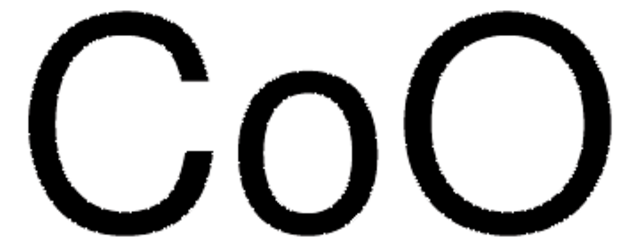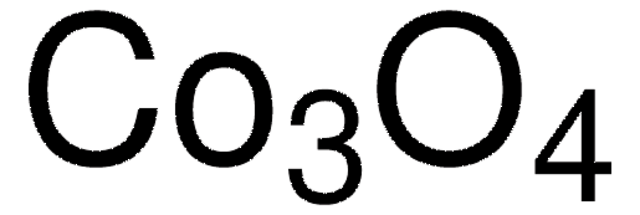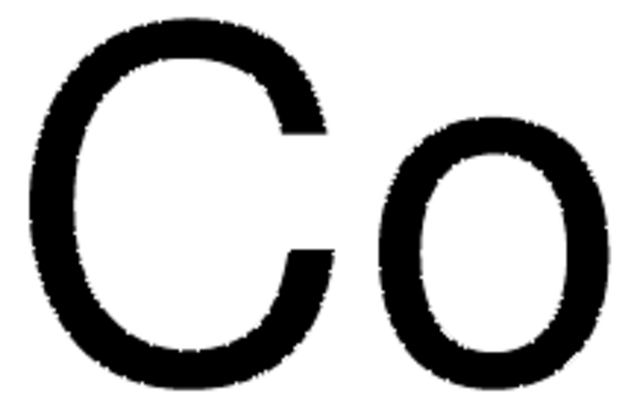637025
Cobalt(II,III) oxide
nanopowder, <50 nm particle size (SEM), 99.5% trace metals basis
Sinonimo/i:
Cobalt tetraoxide, Cobaltic-cobaltous oxide, Tricobalt tetraoxide
About This Item
Prodotti consigliati
Saggio
99.5% trace metals basis
Stato
nanopowder
Area superficiale
40-70 m2/g , typical range
Dimensione particelle
<50 nm (SEM)
Punto di fusione
895 °C (dec.) (lit.)
Densità
6.11 g/mL at 25 °C (lit.)
Densità bulk
0.57 g/mL
applicazioni
battery manufacturing
Stringa SMILE
O=[Co].O=[Co]O[Co]=O
InChI
1S/3Co.4O
LBFUKZWYPLNNJC-UHFFFAOYSA-N
Cerchi prodotti simili? Visita Guida al confronto tra prodotti
Descrizione generale
Applicazioni
- To modify the glassycarbon electrode for the detection of As(III) at nanomolar concentrationrange.
- To prepare a robust photocatalyst along withcarbon nanospheres for dye degradation and hydrogen evolution reaction.
- As an electrodematerial in the preparation of supercapacitors.
Avvertenze
Danger
Indicazioni di pericolo
Consigli di prudenza
Classi di pericolo
Aquatic Chronic 3 - Carc. 1A Inhalation - Resp. Sens. 1
Codice della classe di stoccaggio
6.1C - Combustible acute toxic Cat.3 / toxic compounds or compounds which causing chronic effects
Classe di pericolosità dell'acqua (WGK)
WGK 1
Punto d’infiammabilità (°F)
Not applicable
Punto d’infiammabilità (°C)
Not applicable
Elenchi normativi
Forniamo informazioni su eventuali restrizioni prevalentemente per i prodotti chimici. Per altre tipologie di prodotto siamo in grado di fornire soltanto informazioni limitate. Nessuna segnalazione significa che nessuno dei componenti è citato in un elenco. È dovere dell’utilizzatore assicurarsi che il prodotto venga impiegato in maniera sicura e a norme di legge.
EU REACH Annex XVII (Restriction List)
Scegli una delle versioni più recenti:
Possiedi già questo prodotto?
I documenti relativi ai prodotti acquistati recentemente sono disponibili nell’Archivio dei documenti.
I clienti hanno visto anche
Articoli
Currently, magnetic nanoparticles (MNPs) are attracting a lot of attention because of the possibility of many novel applications, especially in biomedical research.
Graphene is a unique two-dimensional (2D) structure of monolayer carbon atoms packed into a dense honeycomb crystal that has attracted great interest due to its diverse and fascinating properties.
Magnetic materials permeate numerous daily activities in our lives. They are essential components of a diversity of products including hard drives that reliably store information on our computers, decorative magnets that keep the shopping list attached to the refrigerator door, electric bicycles that speed our commute to work, as well as wind turbines for conversion of wind energy to electrical power.
The application of magnetism and magnetic materials pervades our modern civilization in the form of electrical power, communications and information storage.
Il team dei nostri ricercatori vanta grande esperienza in tutte le aree della ricerca quali Life Science, scienza dei materiali, sintesi chimica, cromatografia, discipline analitiche, ecc..
Contatta l'Assistenza Tecnica.











